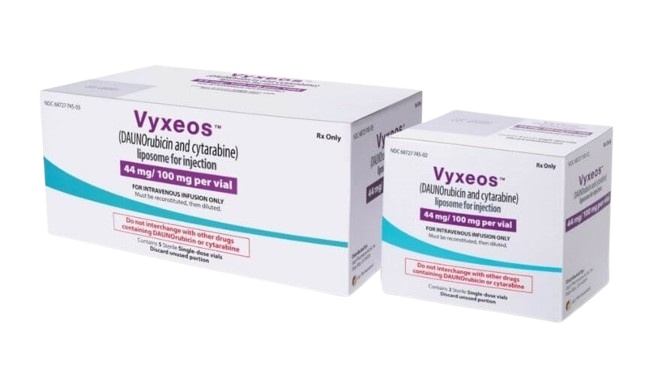Vyxeos是由阿糖胞苷和柔红霉素按照5:1的比例组合而成的脂质体药物。这种纳米级脂质体递送载体可增强疗效,同时限制了单独服用每种药物的风险。与单独接受这两种药物治疗相比,Vyxeos可增加协同作用,减少拮抗作用,显著提高化疗效果,延长患者的生存时间。
药品称呼
通用名:Daunorubicin and cytarabine
商品名:Vyxeos
全部名称:柔红霉素/阿糖胞苷复方冻干粉注射剂,Vyxeos,Daunorubicin and cytarabine
禁忌
禁止使用其他含有柔红霉素和阿糖胞苷的产品替换本品。
对柔红霉素,阿糖胞苷或制剂中任何成分过敏。
注意事项
(1)严重或致命出血伴持续性血小板减少:在恢复正常前需监测血细胞计数。
(2)心脏毒性:不建议心脏功能差的患者使用VYXEOS。心脏功能受损的患者应终止使用VYXEOS,除非使用VYXEOS利大于弊。
(3)若发生重度或危及生命的过敏反应,停止使用VYXEOS,使用标准处理方法给予治疗,监测直到症状体征缓解。
(4)柔红霉素可能导致药物溢出部位的局部组织坏死,输注时需要注意监测。
(5)胚胎毒性:可能致胎儿危害。告知患者对胎儿的潜在风险和使用有效避孕。
贮藏
将未重构的VYXEOS样品瓶存放在冰箱中,温度为2°C至8°C(36°F至46°F),直立。
小瓶应存放在其原始纸箱中以防光。
作用机制
用于注射的VYXEOS(柔红霉素和阿糖胞苷)脂质体是柔红霉素和阿糖胞苷的脂质体制剂,其固定的摩尔比为1:5。已显示柔红霉素:阿糖胞苷的1:5摩尔比在体外和鼠模型中杀死白血病细胞具有协同作用。
柔红霉素具有抗有丝分裂和细胞毒活性,其特征在于DNA形成,抑制拓扑异构酶II活性,抑制DNA聚合酶活性,影响基因表达的调节和DNA损伤自由基。阿糖胞苷是细胞周期阶段特异性抗肿瘤剂,仅在细胞分裂的S期期间影响细胞。阿糖胞苷通过抑制DNA聚合酶起作用。
基于动物数据,脂质体进入并持续存在于骨髓中,在那里它们被骨髓细胞完整地取出。在携带白血病的小鼠中,脂质体被白血病细胞摄取的程度大于正常骨髓细胞。细胞内化后,脂质体经历降解,在细胞内环境中释放出阿糖胞苷和柔红霉素。
安全与疗效
Vyxeos,原名为CPX-351,是阿糖胞苷和柔红霉素按照 5:1的比例组合的脂质体,可增加协同作用,减少拮抗作用。
在一项重要的3期临床试验中,研究人员比较了Vyxeos和单用“7+3”方案(柔红霉素及阿糖胞苷)对309 名新诊断的t-AML 或 AML-MRC患者的安全性和有效性。
主要终点是总生存期(OS)。结果显示,Vyxeos表现出显著的优势:中位OS为9.6个月,而对照组为5.9个月(p = 0.005;HR=0.69;95%CI,0.52 - 0.90);完全缓解率为38% vs 26%,有统计学意义的改善(P =0. 036);整体上,30天的死亡率为6% vs 11%。
Vyxeos(cytarabine/ daunorubicin liposomal)
Indication
VYXEOS (daunorubicin and cytarabine) liposome for injection 44 mg/100 mg is indicated for the treatment of adults with newly-diagnosed therapy-related acute myeloid leukemia (t-AML) or AML with myelodysplasia-related changes (AML-MRC).
Important Safety Information
WARNING:
DO NOT INTERCHANGE WITH OTHER DAUNORUBICIN AND/OR CYTARABINE-CONTAINING PRODUCTS
VYXEOS has different dosage recommendations than daunorubicin hydrochloride injection, cytarabine injection, daunorubicin citrate liposome injection, and cytarabine liposome injection. Verify drug name and dose prior to preparation and administration to avoid dosing errors.
Contraindications
VYXEOS is contraindicated in patients with a history of serious hypersensitivity reactions to cytarabine, daunorubicin, or any component of the formulation.
Warnings and Precautions
Hemorrhage
Serious or fatal hemorrhage events, including fatal CNS hemorrhages, associated with prolonged thrombocytopenia, have occurred with VYXEOS. The overall incidence (grade 1-5) of hemorrhagic events was 74% in the VYXEOS arm and 56% in the control arm. The most frequently reported hemorrhagic event was epistaxis (36% in VYXEOS arm and 18% in control arm). Grade 3 or greater events occurred in 12% of VYXEOS-treated patients and in 8% of patients in the control arm. Fatal treatment-emergent CNS hemorrhage not in the setting of progressive disease occurred in 2% of patients in the VYXEOS arm and in 0.7% of patients in the control arm. Monitor blood counts regularly and administer platelet transfusion support as required.
Cardiotoxicity
VYXEOS contains daunorubicin, which has a known risk of cardiotoxicity. This risk may be increased in patients with prior anthracycline therapy, preexisting cardiac disease, previous radiotherapy to the mediastinum, or concomitant use of cardiotoxic drugs. Assess cardiac function prior to VYXEOS treatment and repeat prior to consolidation and as clinically required. Discontinue VYXEOS in patients with impaired cardiac function unless the benefit of initiating or continuing treatment outweighs the risk. VYXEOS is not recommended in patients with cardiac function that is less than normal.
Total cumulative doses of non-liposomal daunorubicin greater than 550 mg/m2 have been associated with an increased incidence of drug-induced congestive heart failure. The tolerable limit appears lower (400 mg/m2) in patients who received radiation therapy to the mediastinum. Calculate the lifetime cumulative anthracycline exposure prior to each cycle of VYXEOS. VYXEOS is not recommended in patients whose lifetime anthracycline exposure has reached the maximum cumulative limit.
Hypersensitivity Reactions
Serious or fatal hypersensitivity reactions, including anaphylactic reactions, have been reported with daunorubicin and cytarabine. Monitor patients for hypersensitivity reactions. If a mild or moderate hypersensitivity reaction occurs, interrupt or slow the rate of infusion with VYXEOS and manage symptoms. If a severe or life-threatening hypersensitivity reaction occurs, discontinue VYXEOS permanently, treat the symptoms, and monitor until symptoms resolve.
Copper Overload
VYXEOS contains copper. Consult with a hepatologist and nephrologist with expertise in managing acute copper toxicity in patients with Wilson’s disease treated with VYXEOS. Monitor total serum copper, serum non-ceruloplasmin-bound copper, 24-hour urine copper levels, and serial neuropsychological examinations during VYXEOS treatment in patients with Wilson’s disease or other copper-related metabolic disorders. Use only if the benefits outweigh the risks. Discontinue in patients with signs or symptoms of acute copper toxicity.
Tissue Necrosis
Daunorubicin has been associated with severe local tissue necrosis at the site of drug extravasation. Administer VYXEOS by the intravenous route only. Do not administer by intramuscular or subcutaneous route.
Embryo-Fetal Toxicity
VYXEOS can cause embryo-fetal harm when administered to a pregnant woman. Patients should avoid becoming pregnant while taking VYXEOS. If VYXEOS is used during pregnancy or if the patient becomes pregnant while taking VYXEOS, apprise the patient of the potential risk to a fetus. Advise females and males of reproductive potential to use effective contraception during treatment and for 6 months following the last dose of VYXEOS.
Most Common Adverse Reactions
The most common adverse reactions (incidence ≥25%) were hemorrhagic events (74%), febrile neutropenia (70%), rash (56%), edema (55%), nausea (49%), mucositis (48%), diarrhea (48%), constipation (42%), musculoskeletal pain (43%), fatigue (39%), abdominal pain (36%), dyspnea (36%), headache (35%), cough (35%), decreased appetite (33%), arrhythmia (31%), pneumonia (31%), bacteremia (29%), chills (27%), sleep disorders (26%), and vomiting (25%).
温馨提示
1.本站提供的医学产品信息并不完整,不能代替有资格的医疗专业人士所提供的咨询意见,相关问题请咨询您的主治医生获得更多的帮助。本站内容作为纯介绍性信息仅供参考。
2.本站内容如有错误请联系客服修正,感谢您的支持和反馈!
3.更多药品相关问题及靠谱仿制药渠道,请咨询客服了解!
 400-028-6288
400-028-6288 在线客服
在线客服
 官方微信
官方微信


 医无忧服务热线:
医无忧服务热线:


















 海外直邮
海外直邮